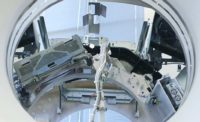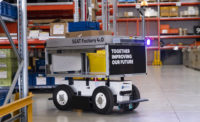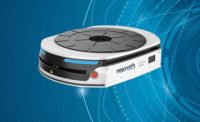Continental Increases Efficiency with Autonomous Mobile Robots
Automotive supplier Continental AG has developed its own line of autonomous automated guided vehicles (AGVs) for transporting parts in its assembly plants and warehouses. The autonomous AGVs can transport loads weighing more than a ton.
Continental’s autonomous AGVs are already being used at the company’s assembly plants in Zvolen, Slovakia, and Frankfurt am Main, Germany, transporting parts and materials for brake production. The AGVs automatically steer themselves to the programmed destinations and flexibly avoid obstacles.
“Increasing efficiency in production is important for long-term competitiveness,” says Alexander Schmitt, head of the actuation and future products segment of Continental’s Autonomous Mobility and Safety business area. “For that reason, we decided to use AGVs to…shape our processes more flexibly and efficiently. …We’re developing an industrial solution that optimizes our production sequences and is also an attractive business idea.”
AGVs play an important role in the material flow of a digitized factory. They reduce the need for forklifts and speed up transport of parts, making it clear exactly what goods are available and where they are at all times. This helps to make processes more predictable.
Standard AGVs cannot drive autonomously; they only move on fixed routes between programmed start and target locations. Any change requires complex reprogramming, time and additional costs for modifications to the site.
During the design, production and assembly of the autonomous AGV, Continental’s project team drew on the company’s experience in the automotive sector. Driver assistance and navigation technologies, such as radar, lidar, cameras and ultrasonic sensors, were critical to the development of the new AGV. Only the electric drivetrain and the software for controlling the vehicle are based on currently available technologies. The aim is for the autonomous AGVs to be deployed at Continental assembly plants worldwide.
The autonomous AGVs are an integral part of Continental’s Industry 4.0 strategy. The aim is to optimize the entire value chain using digitized processes and data flows with high transparency and predictability, short throughput times, low inventories, and high flexibility.
AGVs Convey Truck Cabs in Automated Paint Lines
Dürr is building two automated paint shops for Sinotruk, a Chinese manufacturer of heavy trucks. Equipped with state-of-the-art technology, the paint shops will be used to coat and paint truck cabs and pickups for Sinotruk’s premium brands, Ji’nan Truck and Ji’nan Commercial Vehicle.
The paint shops are being built in Laiwu and Zhangqiu in the eastern Chinese province of Shandong.
Dürr’s EcoProFleet line of AGVs will transport the vehicle bodies through the line, allowing for a flexible layout and enabling Sinotruk to expand the line or integrate new models in the future. The AGVs are specifically designed for use in paint shops and are already in use in passenger car production. With the Sinotruk lines, the AGVs are being used to transport truck cabs for the first time.
The EcoProFleet AGVs can carry a maximum load of 1,000 kilograms. The fleet is intelligently controlled by DXQ control software, which ensures that all AGVs execute their transport assignments and are always on the move. The AGVs are fully charged in just 1.5 minutes. Charging points are located where the AGVs are stationary for picking up or setting down truck bodies.
At the beginning of the painting process, truck bodies pass through Dürr’s RoDip E rotational dip process, which enables engineers to individualize the pretreatment and cathodic electrocoating processes to optimize quality when running different cab models.
Each cab is transported through the pretreatment and electrocoating processes using a freely programmable trolley. Each trolley has a conveying drive and a rotating drive, which enable horizontal and rotating movements to be controlled independently for each cab. The immersion tanks for the rotational process are smaller than with a traditional pendulum conveyor, which means that less energy and chemicals are required. This saves resources and reduces operating costs.
Next, two EcoRS sealing robots from Dürr seal the inner seams, and another two apply liquid sound deadener in a fully automatic process. Then, a base coat and clear coat in each paint shop are applied by 19 EcoRP painting robots, which are equipped with EcoBell3 high-rotation atomizers.
The robots enable Sinotruk to achieve the best possible painting results in terms of color shade, flow values and uniform layer thicknesses. At the same time, the technology is more environmentally friendly. High-rotation atomizers with electrostatic charging use material efficiently. With the color change technology and the EcoBell Cleaner D2 for cleaning atomizers, paint loss during color changes and consumption of flushing agent and solvent are also minimized.
Dürr’s EcoDry X dry separation system, which doesn’t require water or chemicals, is another technology used in the new paint shops. The system uses inexpensive cardboard filter boxes to efficiently separate overspray. Another benefit of the technology is how easy it is to use. If necessary, saturated filter boxes can even be replaced during production.
At the end of the painting process, the body surface is checked at a quality control station. In most paint shops, this is done manually and only a random sample of bodies are checked. For Sinotruk, Dürr is installing a fully automatic quality control station. Here, a robot inspects defined checkpoints on the truck cabs and uses sensors to record data about color variations, surface texture and layer thickness. This automation saves time compared to manual measurement. This data is transferred to a database and displayed on an HMI so engineers can keep track of key performance indicators.
Outside of the painting process, end-of-line testing technology is also from Dürr. In Laiwu, four test stands equipped with high-precision 3D measurement technology are used to measure and adjust the vehicle axis geometry. In addition, driver assistance systems are precisely adjusted using Dürr test technology. With the modular test stand concept x-DASalign, the sensor technology for the lane departure warning system and the advanced emergency braking system are perfectly aligned in relation to the geometric driving axle of the vehicle.
ABB Partners With Swiss Start-Up to Enhance Autonomous Mobile Robots
ABB is partnering with Swiss-based start-up Sevensense to equip ABB’s autonomous mobile robots (AMRs) with artificial intelligence and 3D vision mapping technology. The technologies will enable ABB’s mobile robots to navigate autonomously in complex, dynamic indoor and outdoor environments close to people.
In July 2021, ABB acquired ASTI Mobile Robotics, a manufacturer of AMR in Burgos, Spain. ABB’s partnership with Sevensense—founded in 2018 as a spin-off from ETH Zurich, a public research university—will enable ABB to enhance the capabilities of its AMR products. The partnership includes a minority investment in Sevensense through ABB’s venture capital unit, ABB Technology Ventures.
“Our partnership with Sevensense is another milestone in our efforts to fully unlock flexible automation for our customers,” says Sami Atiya, president of ABB Robotics & Discrete Automation. “Integrating Sevensense’s AI and 3D mapping technology with our AMR offerings will help accelerate the replacement of today’s linear production lines with fully flexible networks. Our vision of the future workplace is one in which AMRs move materials, parts and finished products between smart workstations in increasingly unstructured, dynamic work environments.”
Sevensense’s navigation technology uses advanced computer vision and AI algorithms to create a 3D map that is more accurate and cost-effective than current technology. An AMR equipped with 3D simultaneous localization and mapping (SLAM) technology will be able to accurately interpret its environment, identify a person, a pallet or another robot and autonomously make decisions to navigate around these obstacles. This level of intelligence will enable safer human-machine interactions and ensure material flows around factories and warehouses are safe and efficient for maximum flexibility and productivity.
Sevensense was selected to partner with ABB Robotics after participating in the 2021 ABB Robotics Innovation Challenge, which evaluated the performance of a range of visual SLAM technologies from multiple businesses.
Low-Profile AGV Carries Heavy Payloads
Measuring 1,550 millimeters long, 800 millimeters wide and just 220 millimeters tall, the new K41 Slim AGV from Kivnon Logistica has a maximum payload of 800 kilograms. Capable of omnidirectional movement, the AGV uses SLAM technology to create a 3D a map of its environment and navigate around unknown obstacles. Maximum speed is 1 meter per second. Laser scanners, an onboard safety PLC, and LED signaling ensure safe operation 360 degrees around the vehicle.
The AGV can be adapted to transport all types of trolleys. It can also transport loads directly via its on-board lift table, which can rise to a height of 370 millimeters. The AGV can even be used as a workbench. It can also be adapted to connect to fleet management systems, including those based on VDA 5050.
90
Maximum capacity, in tons, of the omniMove heavy-duty AGV from KUKA. The AGV can be controlled manually or move autonomously. Despite its enormous size and payload capacity, it navigates safely, moving virtually independently. Specially developed wheels allow the AGV to move in any direction, even from a standing start. A sophisticated navigation system ensures autonomous maneuvering without risk of collision and without requiring floor markings. The modular AGV can be scaled in size, width and length to accommodate a variety of loads.






